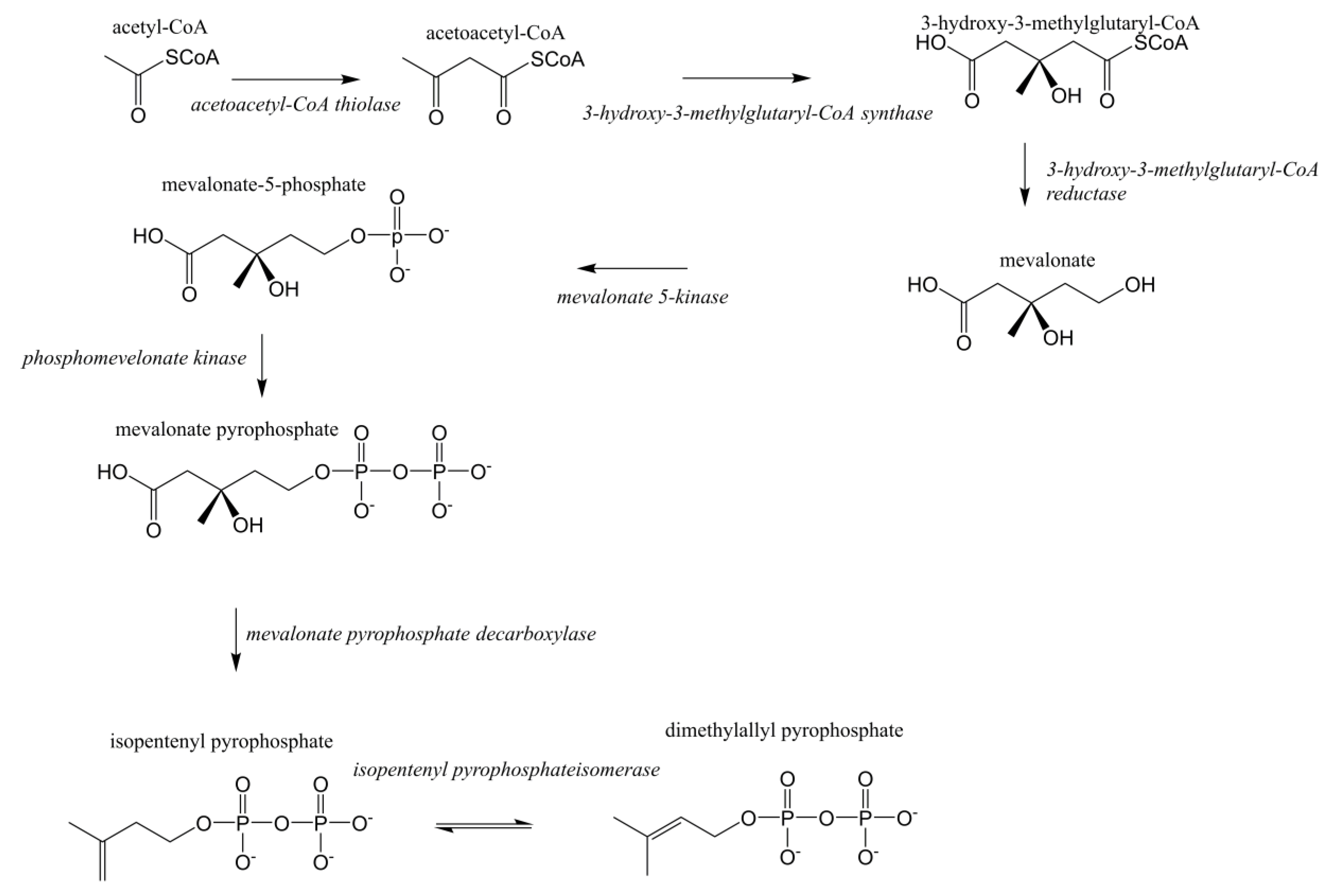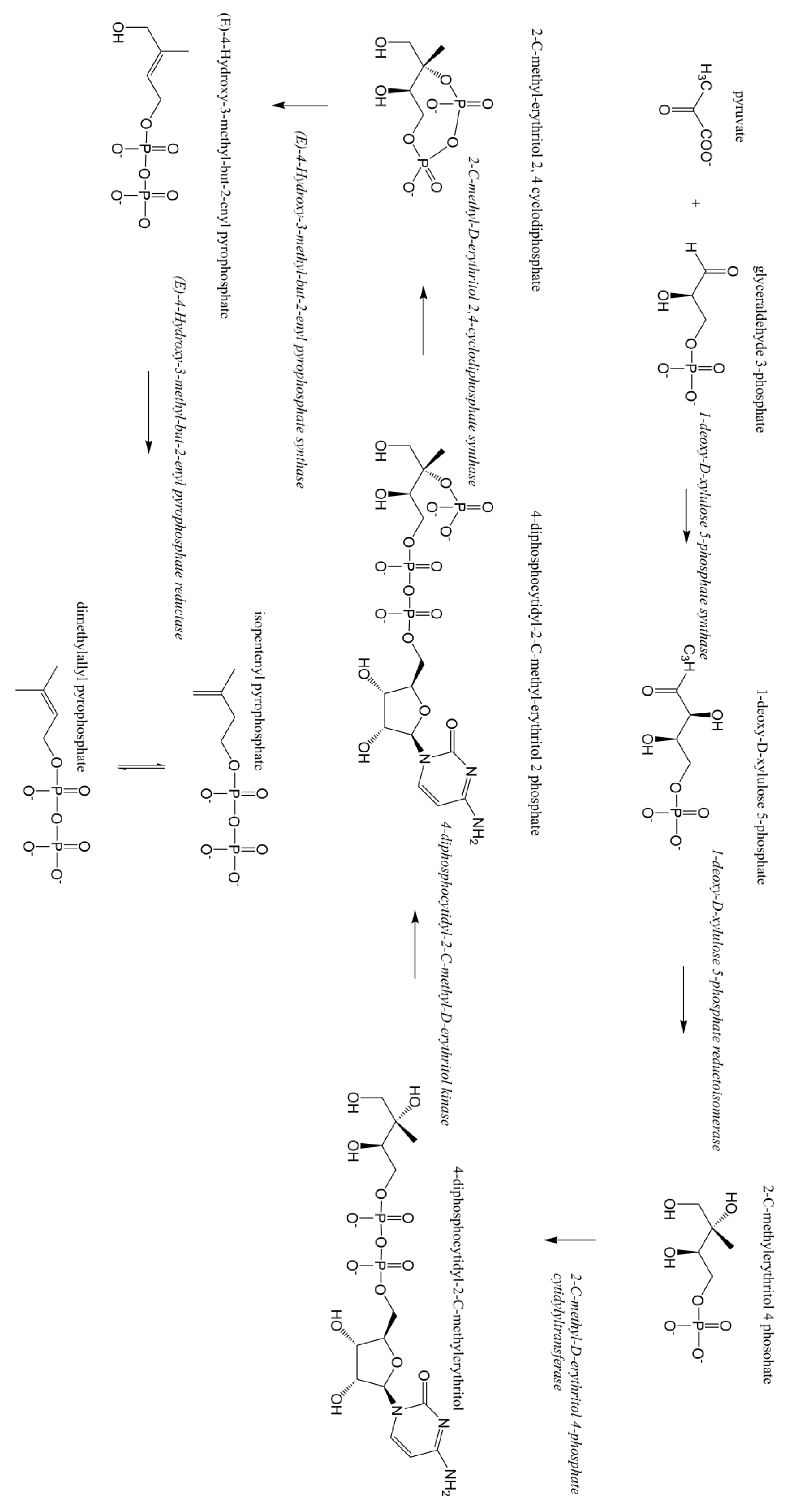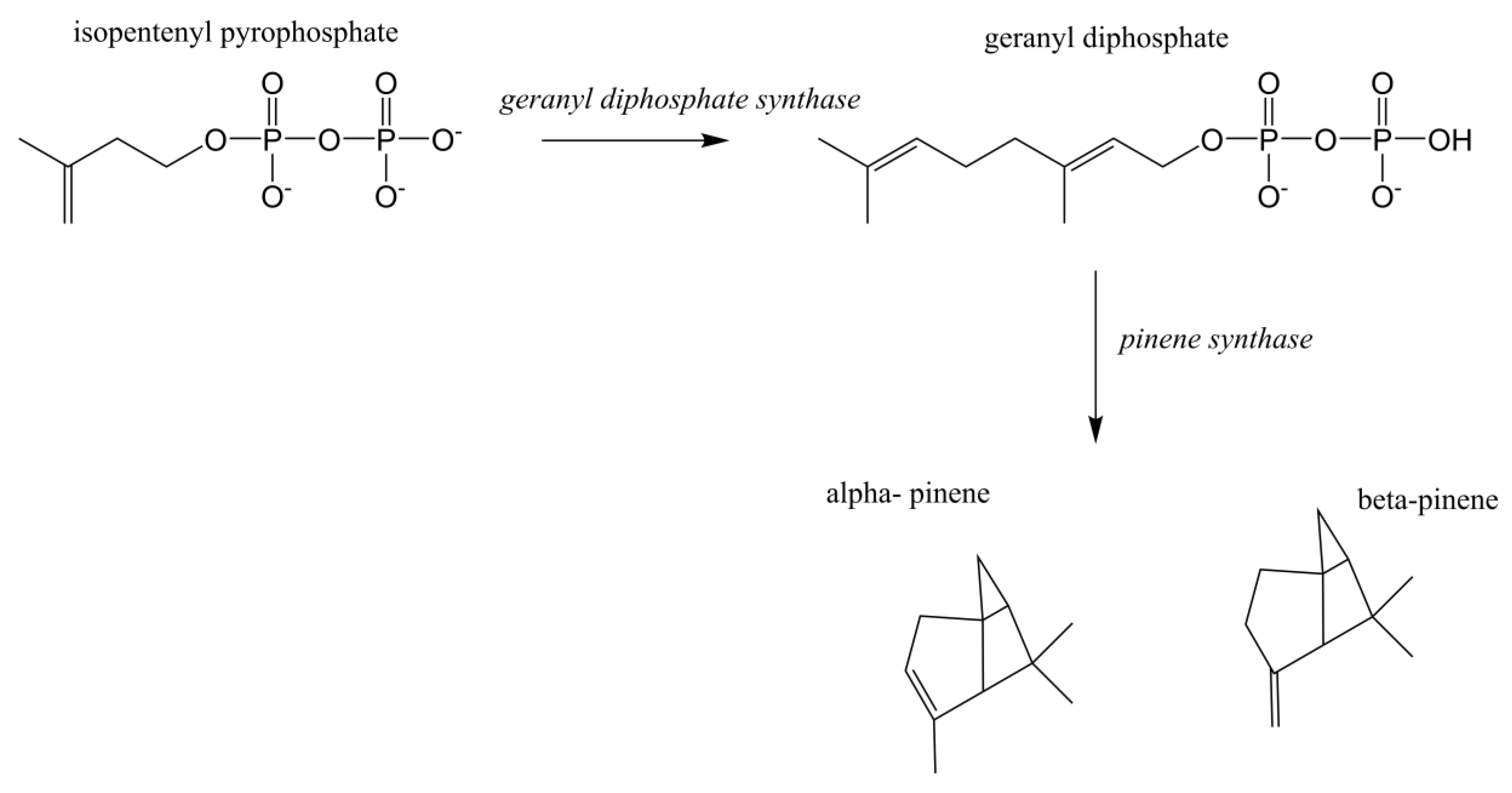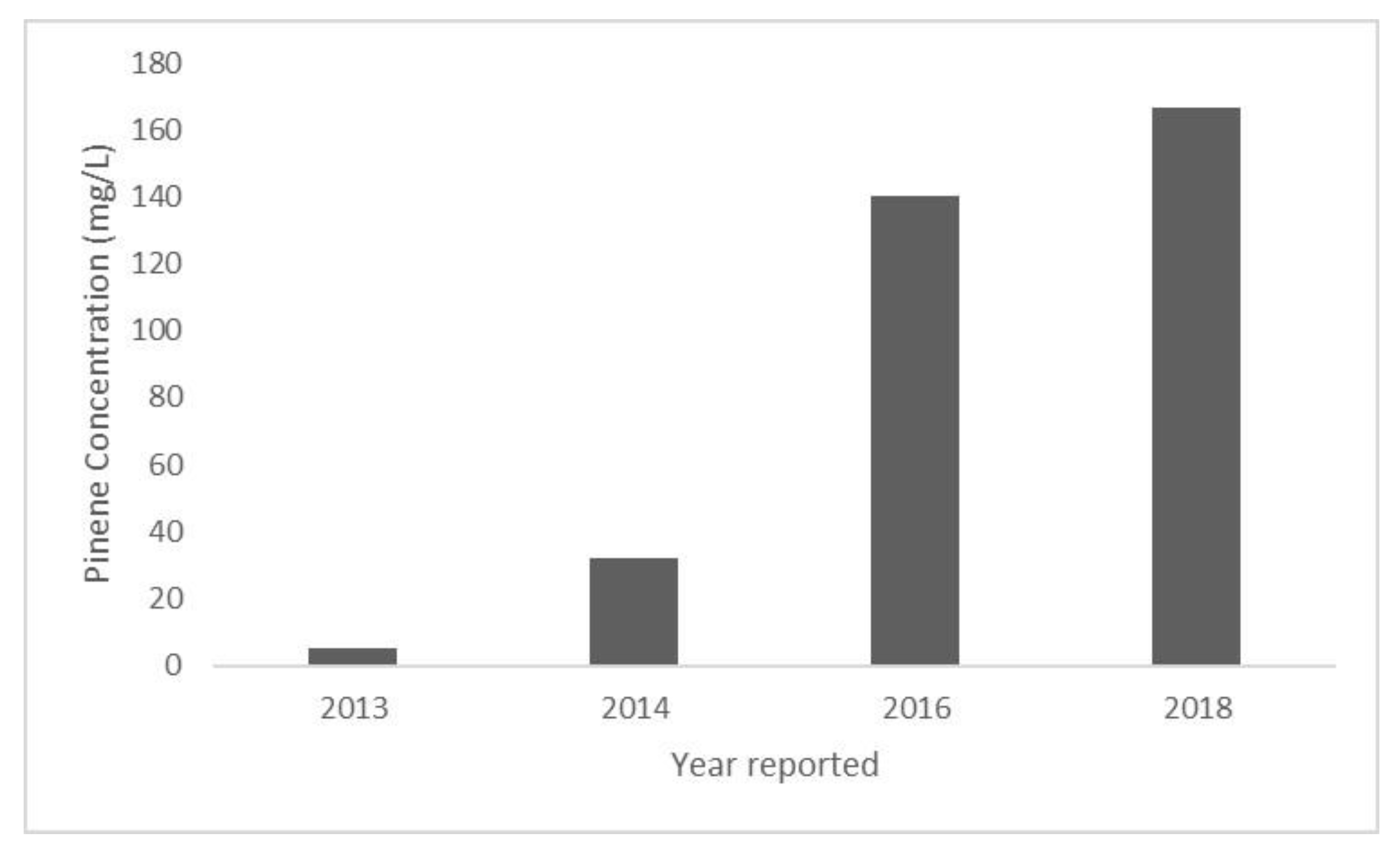The Potential Production of the Bioactive Compound Pinene Using Whey Permeate
Abstract
1. Introduction
2. Applications of Pinene
3. Plant Pinene Biosynthesis and Purification
4. Microbial Pinene Biosynthesis
4.1. E. coli
4.2. S. cereviseae and K. marxianus
4.3. Corynebacterium glutamicum and Rhodosporidium torulides
5. Possible Challenges for Large-Scale Synthesis of Pinene by Microorganisms
6. Whey as a Feedstock for Microbial Pinene Production
7. Whey Standardization and Pinene Recovery
8. Conclusions
Author Contributions
Funding
Conflicts of Interest
References
- Miyazawa, M.; Yamafuji, C. Inhibition of Acetylcholinesterase Activity by Bicyclic Monoterpenoids. J. Agric. Food Chem. 2005, 53, 1765–1768. [Google Scholar] [CrossRef]
- Miller, J.A.; Thompson, P.A.; Hakim, I.A.; Chow, H.-H.S.; Thomson, C.A. d-Limonene: A Bioactive Food Component from Citrus and Evidence for a Potential Role in Breast Cancer Prevention and Treatment. Oncol. Rev. 2011, 5, 31–42. [Google Scholar] [CrossRef]
- George, K.W.; Alonso-Gutierrez, J.; Keasling, J.D.; Lee, T.S. Isoprenoid Drugs, Biofuels, and Chemicals—Artemisinin, Farnesene, and Beyond; Springer: Cham, Swizerland, 2015; pp. 355–389. [Google Scholar]
- Clomburg, J.M.; Crumbley, A.M.; Gonzalez, R. Industrial Biomanufacturing: The Future of Chemical production. Science (80-. ) 2017, 355, aag0804. [Google Scholar] [CrossRef]
- Chang, M.C.Y.; Keasling, J.D. Production of Isoprenoid Pharmaceuticals by Engineered Microbes. Nat. Chem. Biol. 2006, 2, 674–681. [Google Scholar] [CrossRef]
- Sarria, S.; Wong, B.; Martín, H.G.; Keasling, J.D.; Peralta-Yahya, P. Microbial Synthesis of Pinene. ACS Synth. Biol. 2014, 3, 466–475. [Google Scholar] [CrossRef]
- Da Silva, A.C.R.; Lopes, P.M.; de Azevedo, M.M.B.; Costa, D.C.M.; Alviano, C.S.; Alviano, D.S. Biological Activities of a-Pinene and β-Pinene Enantiomers. Molecules 2012, 17, 6305–6316. [Google Scholar] [CrossRef] [PubMed]
- Yang, J.; Nie, Q.; Ren, M.; Feng, H.; Jiang, X.; Zheng, Y.; Liu, M.; Zhang, H.; Xian, M. Metabolic Engineering of Escherichia coli for the Biosynthesis of Alpha-Pinene. Biotechnol. Biofuels 2013, 6, 60. [Google Scholar] [CrossRef] [PubMed]
- Goudarzi, S.; Rafieirad, M. Evaluating the Effect of α-Pinene on Motor Activity, Avoidance Memory and Lipid Peroxidation in Animal Model of Parkinson Disease in Adult Male Rats. Res. J. Pharmacogn. 2017, 4, 53–63. [Google Scholar]
- Lee, G.-Y.; Lee, C.; Park, G.H.; Jang, J.-H. Amelioration of Scopolamine-Induced Learning and Memory Impairment by α -Pinene in C57BL/6 Mice. Evidence-Based Complement. Altern. Med. 2017, 2017, 1–9. [Google Scholar] [CrossRef] [PubMed]
- Chen, W.; Vermaak, I.; Viljoen, A. Camphor—A Fumigant during the Black Death and a Coveted Fragrant Wood in Ancient Egypt and Babylon—A Review. Molecules 2013, 18, 5434–5454. [Google Scholar] [CrossRef] [PubMed]
- World Health Organization. Evaluations of the Joint FAO/WHO Expert Committee on Food Additives-Verbenone; World Health Organization: Geneva, Switzerland, 2019; p. 1. [Google Scholar]
- Wu, W.; Maravelias, C.T. Synthesis and Techno-Economic Assessment of Microbial-Based Processes for Terpenes Production. Biotechnol. Biofuels 2018, 11, 294. [Google Scholar] [CrossRef] [PubMed]
- Schipper, M. As U.S. Airlines Carry More Passengers, Jet Fuel Use Remains Well Below its Previous Peak—Today in Energy; U.S. Energy Information Administration (EIA) United States Department of Energy: Washington, DC, USA, 2017.
- Al-Hamimi, S.; Abellan Mayoral, A.; Cunico, L.P.; Turner, C. Carbon Dioxide Expanded Ethanol Extraction: Solubility and Extraction Kinetics of α-Pinene and cis-Verbenol. Anal. Chem. 2016, 88, 4336–4345. [Google Scholar] [CrossRef] [PubMed]
- Niu, F.-X.; He, X.; Wu, Y.-Q.; Liu, J.-Z. Enhancing Production of Pinene in Escherichia coli by Using a Combination of Tolerance, Evolution, and Modular Co-culture Engineering. Front. Microbiol. 2018, 9, 1623. [Google Scholar] [CrossRef] [PubMed]
- Behr, A.; Johnen, L. Myrcene as a Natural Base Chemical in Sustainable Chemistry: A Critical Review. ChemSusChem 2009, 2, 1072–1095. [Google Scholar] [CrossRef]
- Jawjit, W.; Kroeze, C.; Soontaranun, W.; Hordijk, L. Options to Reduce the Environmental Impact by Eucalyptus-based Kraft Pulp Industry in Thailand: Model Description. J. Clean. Prod. 2007, 15, 1827–1839. [Google Scholar] [CrossRef]
- Bajpai, P. Pulping Fundamentals. In Biermann’s Handbook of Pulp and Paper; Elsevier: Amsterdam, The Netherlands, 2018; pp. 295–351. ISBN 978-0-12-814240-0. [Google Scholar]
- Bajpai, P. Kraft Spent Liquor Recovery. In Biermann’s Handbook of Pulp and Paper; Elsevier: Amsterdam, The Netherlands, 2018; pp. 425–451. ISBN 978-0-12-814240-0. [Google Scholar]
- Haneke, K. Turpentine (Turpentine Oil, Wood Turpentine, Sulfate Turpentine, Sulfite Turpentine) [8006-64-2] Review of Toxicological Literature; Integrated Laboratory Systems: Morrisville, NC, USA, 2002. [Google Scholar]
- Al-Asheh, S.; Allawzi, M.; Al-Otoom, A.; Allaboun, H.; Al-Zoubi, A. Supercritical Fluid Extraction of Useful Compounds from Sage. Nat. Sci. 2012, 04, 544–551. [Google Scholar] [CrossRef]
- Burdock, G. Fenaroli’s handbook of flavor ingredients, 6th ed.; CRC Press: Boca Raton, FL, USA, 2010; Volume 14, ISBN 9781420090772. [Google Scholar]
- Vickers, C.E.; Behrendorff, J.B.Y.H.; Bongers, M.; Brennan, T.C.R.; Bruschi, M.; Nielsen, L.K. Production of Industrially Relevant Isoprenoid Compounds in Engineered Microbes. In Microorganisms in Biorefineries; Springer: Berlin/Heidelberg, Germany, 2015; pp. 303–334. ISBN 978-3-662-45209-7. [Google Scholar]
- Meadows, A.L.; Hawkins, K.M.; Tsegaye, Y.; Antipov, E.; Kim, Y.; Raetz, L.; Dahl, R.H.; Tai, A.; Mahatdejkul-Meadows, T.; Xu, L.; et al. Rewriting Yeast Central Carbon Metabolism for Industrial Isoprenoid Production. Nature 2016, 537, 694–697. [Google Scholar] [CrossRef]
- Tashiro, M.; Kiyota, H.; Kawai-Noma, S.; Saito, K.; Ikeuchi, M.; Iijima, Y.; Umeno, D. Bacterial Production of Pinene by a Laboratory-Evolved Pinene-Synthase. ACS Synth. Biol. 2016, 5, 1011–1020. [Google Scholar] [CrossRef]
- Amiri, P.; Shahpiri, A.; Asadollahi, M.A.; Momenbeik, F.; Partow, S. Metabolic Engineering of Saccharomyces cerevisiae for Linalool Production. Biotechnol. Lett. 2016, 38, 503–508. [Google Scholar] [CrossRef]
- Bröker, J.N.; Müller, B.; van Deenen, N.; Prüfer, D.; Schulze Gronover, C. Upregulating the Mevalonate Pathway and Repressing Sterol Synthesis in Saccharomyces cerevisiae Enhances the Production of Triterpenes. Appl. Microbiol. Biotechnol. 2018, 102, 6923–6934. [Google Scholar] [CrossRef]
- Ignea, C.; Cvetkovic, I.; Loupassaki, S.; Kefalas, P.; Johnson, C.B.; Kampranis, S.C.; Makris, A.M. Improving Yeast Strains using Recyclable Integration Cassettes, for the Production of Plant Terpenoids. Microb. Cell Fact. 2011, 10, 4. [Google Scholar] [CrossRef] [PubMed]
- Ignea, C.; Pontini, M.; Maffei, M.E.; Makris, A.M.; Kampranis, S.C. Engineering Monoterpene Production in Yeast Using a Synthetic Dominant Negative Geranyl Diphosphate Synthase. ACS Synth. Biol. 2014, 3, 298–306. [Google Scholar] [CrossRef] [PubMed]
- Kang, M.-K.; Eom, J.-H.; Kim, Y.; Um, Y.; Woo, H.M. Biosynthesis of Pinene from Glucose using Metabolically-Engineered Corynebacterium glutamicum. Biotechnol. Lett. 2014, 36, 2069–2077. [Google Scholar] [CrossRef] [PubMed]
- International Mycological Association Rhodosporidium toruloide 2016, Online Database. Available online: http://www.mycobank.org/BioloMICS.aspx?TableKey=14682616000000089&Rec=1019&Fields=All (accessed on 16 December 2019).
- Zhuang, X.; Kilian, O.; Monroe, E.; Ito, M.; Tran-Gymfi, M.B.; Liu, F.; Davis, R.W.; Mirsiaghi, M.; Sundstrom, E.; Pray, T.; et al. Monoterpene Production by the Carotenogenic Yeast Rhodosporidium toruloides. Microb. Cell Fact. 2019, 18, 54. [Google Scholar] [CrossRef]
- Ren, Z.-Y.; Liu, G.-L.; Chi, Z.; Han, Y.-Z.; Hu, Z.; Chi, Z.-M. Overexpression of Both the Lactase Gene and its Transcriptional Activator Gene Greatly Enhances Lactase Production by Kluyveromyces marxianus. Process Biochem. 2017, 61, 38–46. [Google Scholar] [CrossRef]
- Nambu-Nishida, Y.; Nishida, K.; Hasunuma, T.; Kondo, A. Development of a Comprehensive Set of Tools for Genome Engineering in a Cold- and Thermo-Tolerant Kluyveromyces marxianus Yeast Strain. Sci. Rep. 2017, 7, 8993. [Google Scholar] [CrossRef]
- Bao, S.-H.; Zhang, D.-Y.; Meng, E. Improving Biosynthetic Production of Pinene through Plasmid Recombination Elimination and Pathway Optimization. Plasmid 2019, 105, 102431. [Google Scholar] [CrossRef]
- Niu, F.-X.; Huang, Y.-B.; Ji, L.-N.; Liu, J.-Z. Genomic and Transcriptional Changes in Response to Pinene Tolerance and Overproduction in Evolved Escherichia coli. Synth. Syst. Biotechnol. 2019, 4, 113–119. [Google Scholar] [CrossRef]
- Fischer, M.J.C.; Meyer, S.; Claudel, P.; Bergdoll, M.; Karst, F. Metabolic Engineering of Monoterpene Synthesis in Yeast. Biotechnol. Bioeng. 2011, 108, 1883–1892. [Google Scholar] [CrossRef]
- Peng, B.; Nielsen, L.K.; Kampranis, S.C.; Vickers, C.E. Engineered Protein Degradation of Farnesyl Pyrophosphate Synthase is an Effective Regulatory Mechanism to Increase Monoterpene Production in Saccharomyces cerevisiae. Metab. Eng. 2018, 47, 83–93. [Google Scholar] [CrossRef]
- Bhattacharya, S.; Esquivel, B.D.; White, T.C. Overexpression or Deletion of Ergosterol Biosynthesis Genes Alters Doubling Time, Response to Stress Agents, and Drug Susceptibility in Saccharomyces cerevisiae. MBio 2018, 9, e01291-18. [Google Scholar] [CrossRef] [PubMed]
- Deng, Y.; Sun, M.; Xu, S.; Zhou, J. Enhanced (S)-Linalool Production by Fusion Expression of Farnesyl Diphosphate Synthase and Linalool Synthase in Saccharomyces cerevisiae. J. Appl. Microbiol. 2016, 121, 187–195. [Google Scholar] [CrossRef] [PubMed]
- Zhao, J.; Li, C.; Zhang, Y.; Shen, Y.; Hou, J.; Bao, X. Dynamic control of ERG20 Expression Combined with Minimized Endogenous Downstream Metabolism Contributes to the Improvement of Geraniol Production in Saccharomyces cerevisiae. Microb. Cell Fact. 2017, 16, 17. [Google Scholar] [CrossRef] [PubMed]
- Parulekar, S.; Birol, G.; Cinar, A.; Undey, C. Introduction. In Batch Fermentation Modeling: Monitoring and Control; Chemical Industries; CRC Press: Boca Raton, FL, USA, 2003; Volume 93, pp. 1–19. ISBN 978-0-8247-4034-4. [Google Scholar]
- Campbel, J.A. Energy from Aerobic vs. Anaerobic Fermentation. J. Chem. Educ. 1973, 50, 535. [Google Scholar]
- Abram, T. Sugars Defined; Michigan State University Extension: Lansing, MI, USA, 2014. [Google Scholar]
- Hughes, P.; Risner, D.; Goddik, L.M. Whey to Vodka. In Whey-Biological Properties and Alternatives; IntechOpen: London, UK, 2018; Available online: https://www.intechopen.com/books/whey-biological-properties-and-alternative-uses/whey-to-vodka (accessed on 16 December 2019).
- Tetra Pak Whey Processing. In Dairy Processing Handbook; Tetrapak, 2019; Available online: https://dairyprocessinghandbook.tetrapak.com/chapter/whey-processing (accessed on 16 December 2019).
- Lee, H.; Cuthbertson, D.J.; Otter, D.E.; Barile, D. Rapid Screening of Bovine Milk Oligosaccharides in a Whey Permeate Product and Domestic Animal Milks by Accurate Mass Database and Tandem Mass Spectral Library. J. Agric. Food Chem. 2016, 64, 6364–6374. [Google Scholar] [CrossRef] [PubMed]
- Dallas, D.C.; Weinborn, V.; de Moura Bell, J.M.L.N.; Wang, M.; Parker, E.A.; Guerrero, A.; Hettinga, K.A.; Lebrilla, C.B.; German, J.B.; Barile, D. Comprehensive Peptidomic and Glycomic Evaluation Reveals that Sweet Whey Permeate from Colostrum is a Source of Milk Protein-Derived Peptides and Oligosaccharides. Food Res. Int. 2014, 63, 203–209. [Google Scholar] [CrossRef]
- Siso, M.I.G. The biotechnological utilization of cheese whey: A review. Bioresour. Technol. 1996, 57, 1–11. [Google Scholar] [CrossRef]
- Pasotti, L.; Zucca, S.; Casanova, M.; Micoli, G.; Cusella De Angelis, M.G.; Magni, P. Fermentation of Lactose to Ethanol in Cheese Whey Permeate and Concentrated Permeate by Engineered Escherichia coli. BMC Biotechnol. 2017, 17, 48. [Google Scholar] [CrossRef]
- Risner, D.; Tomasino, E.; Hughes, P.; Meunier-Goddik, L. Volatile Aroma Composition of Distillates Produced from Fermented Sweet and Acid Whey. J. Dairy Sci. 2019, 102, 202–210. [Google Scholar] [CrossRef]
- Akbas, M.Y.; Sar, T.; Ozcelik, B. Improved Ethanol Production from Cheese Whey, Whey Powder, and Sugar Beet Molasses by “ Vitreoscilla hemoglobin expressing” Escherichia coli. Biosci. Biotechnol. Biochem. 2014, 78, 687–694. [Google Scholar] [CrossRef]
- Sar, T.; Stark, B.C.; Yesilcimen Akbas, M. Effective Ethanol Production from Whey Powder through Immobilized E. coli Expressing Vitreoscilla Hemoglobin. Bioengineered 2017, 8, 171–181. [Google Scholar] [CrossRef] [PubMed]
- Guimarães, P.M.R.; François, J.; Parrou, J.L.; Teixeira, J.A.; Domingues, L. Adaptive Evolution of a Lactose-consuming Saccharomyces cerevisiae recombinant. Appl. Environ. Microbiol. 2008, 74, 1748–1756. [Google Scholar] [CrossRef] [PubMed]
- Sreekrishna, K.; Dickson, R.C. Construction of Strains of Saccharomyces cerevisiae that Grow on Lactose. Proc. Natl. Acad. Sci. USA 1985, 82, 7909–7913. [Google Scholar] [CrossRef] [PubMed]
- Lawton, M.R.; Alcaine, S.D. Leveraging Endogenous Barley Enzymes to Turn Lactose-Containing Dairy By-products into Fermentable Adjuncts for Saccharomyces cerevisiae-based Ethanol Fermentations. J. Dairy Sci. 2019, 102, 2044–2050. [Google Scholar] [CrossRef]
- Liu, J.-J.; Zhang, G.-C.; Oh, E.J.; Pathanibul, P.; Turner, T.L.; Jin, Y.-S. Lactose Fermentation by Engineered Saccharomyces cerevisiae Capable of Fermenting Cellobiose. J. Biotechnol. 2016, 234, 99–104. [Google Scholar] [CrossRef]
- Barrett, E.; Stanton, C.; Zelder, O.; Fitzgerald, G.; Ross, R.P. Heterologous Expression of Lactose- and Galactose-utilizing Pathways from Lactic Acid Bacteria in Corynebacterium glutamicum for Production of Lysine in Whey. Appl. Environ. Microbiol. 2004, 70, 2861–2866. [Google Scholar] [CrossRef] [PubMed]
- Akhtar, P.; Gray, J.I.; Asghar, A. Synthesis of Lipids by Certain Yeast Strains Grown on Whey Permeate. J. Food Lipids 1998, 5, 283–297. [Google Scholar] [CrossRef]
- Banat, I.M.; Nigam, P.; Marchant, R. Isolation of Thermotolerant, Fermentative Yeasts Growing at 52 °C and Producing Ethanol at 45 °C and 50 °C. World J. Microbiol. Biotechnol. 1992, 8, 259–263. [Google Scholar] [CrossRef]
- Groeneveld, P.; Stouthamer, A.H.; Westerhoff, H.V. Super Life—How and Why ‘Cell Selection’ Leads to the Fastest-Growing Eukaryote. FEBS J. 2009, 276, 254–270. [Google Scholar] [CrossRef]
- Cernak, P.; Estrela, R.; Poddar, S.; Skerker, J.M.; Cheng, Y.-F.; Carlson, A.K.; Chen, B.; Glynn, V.M.; Furlan, M.; Ryan, O.W.; et al. Engineering Kluyveromyces marxianus as a Robust Synthetic Biology Platform Host. MBio 2018, 9, e01410-18. [Google Scholar] [CrossRef]
- Ibdah, M.; Muchlinski, A.; Yahyaa, M.; Nawade, B.; Tholl, D. Carrot Volatile Terpene Metabolism: Terpene Diversity and Biosynthetic Genes; Springer: Cham, Switzerland, 2019; pp. 279–293. [Google Scholar]
- Duarte, S.H.; dos Santos, P.; Michelon, M.; de Pinho Oliveira, S.M.; Martínez, J.; Maugeri, F. Recovery of yeast lipids using Different Cell Disruption Techniques and Supercritical CO2 Extraction. Biochem. Eng. J. 2017, 125, 230–237. [Google Scholar] [CrossRef]
- Reverchon, E. Supercritical Fluid Extraction and Fractionation of Essential Oils and Related Products. J. Supercrit. Fluids 1997, 10, 1–37. [Google Scholar] [CrossRef]




| Recombinant Microorganisms | ||||||
|---|---|---|---|---|---|---|
| E. coli [6,16,24,26] | S. cerevisiae [24,27,28,29,30] | C. glutamicum [31] | R. toruloides [32,33] | K. marxianus [34,35] | ||
| Pros | Genetic traceability | + | + | |||
| Generally recognized as safe | + | + | + | + | ||
| Focus of current research | + | |||||
| Metabolizes lactose | + | + | ||||
| Metabolizes galactose | + | + | + | + | ||
| Reported levels of pinene production greater than 1 mg/L | + | |||||
| Used for commercial production of ethanol or other metabolites | + | + | + | + | ||
| Commercial production using whey permeate as medium | + | |||||
| Cons | Potential extraction difficulties due to outer membrane | − | ||||
| LPS (endotoxin) | − | |||||
| Native MVA pathway with competing enzymes | − | − | ||||
| Little to no research related to pinene production | − | − | − | |||
| Protein (% w/w) | Lactose (% w/w) | Non-Nitrogen Protein (% w/w) | Ash (% w/w) | Fat (% w/w) | |
|---|---|---|---|---|---|
| Whey | 0.6 | 4.5 | 0.20 | 0.50 | 0.03 |
| Whey Permeate | 0.01 | 4.5 | 0.20 | 0.50 | n.d.a |
© 2020 by the authors. Licensee MDPI, Basel, Switzerland. This article is an open access article distributed under the terms and conditions of the Creative Commons Attribution (CC BY) license (http://creativecommons.org/licenses/by/4.0/).
Share and Cite
Risner, D.; Marco, M.L.; Pace, S.A.; Spang, E.S. The Potential Production of the Bioactive Compound Pinene Using Whey Permeate. Processes 2020, 8, 263. https://doi.org/10.3390/pr8030263
Risner D, Marco ML, Pace SA, Spang ES. The Potential Production of the Bioactive Compound Pinene Using Whey Permeate. Processes. 2020; 8(3):263. https://doi.org/10.3390/pr8030263
Chicago/Turabian StyleRisner, Derrick, Maria L. Marco, Sara A. Pace, and Edward S. Spang. 2020. "The Potential Production of the Bioactive Compound Pinene Using Whey Permeate" Processes 8, no. 3: 263. https://doi.org/10.3390/pr8030263
APA StyleRisner, D., Marco, M. L., Pace, S. A., & Spang, E. S. (2020). The Potential Production of the Bioactive Compound Pinene Using Whey Permeate. Processes, 8(3), 263. https://doi.org/10.3390/pr8030263





